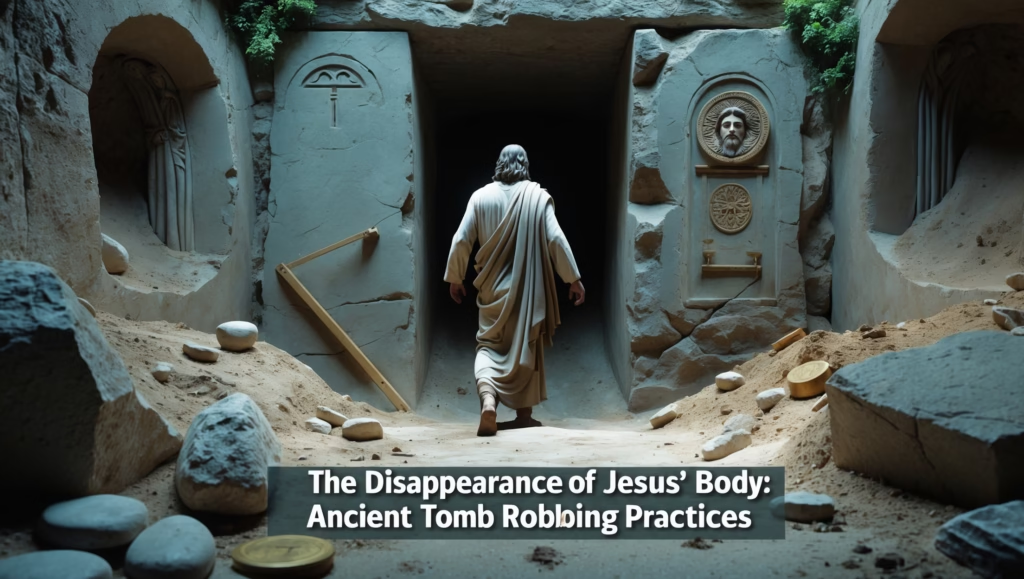The resurrection of Jesus is central to Christian faith, yet the Gospel accounts repeatedly note the fear of body theft (Matthew 27:62–66). While believers point to divine intervention, forensic archaeology and historical studies reveal a more mundane—but fascinating—context: tomb security, grave robbery, and the realities of 1st-century burial practices in Jerusalem. Understanding these factors offers fresh insight into the Gospel narratives and highlights how socio-cultural conditions could shape theological claims.

Tomb Security in 1st-Century Judea
The Gospel of Matthew describes Roman guards and sealed tombs, emphasizing the impossibility of human interference. Archaeological evidence, however, suggests that tombs of the era were both vulnerable and frequently targeted:
- Rolling Stones: Many tombs used a large, circular stone to seal entrances. Experimental archaeology shows that a stone of 1–2 tons could be moved by 2–3 coordinated men using simple levers and ropes, without modern machinery. While angels may have rolled the stone in the narrative, humans could also accomplish the task.
- Vault Designs: Tombs often contained a short passage, burial niches, and minimal structural reinforcement. While some were rock-cut and complex, most had entryways susceptible to manipulation, particularly under cover of darkness.
- Grave Goods: Burial sites typically contained valuable oils, spices, and personal items, creating strong incentives for theft. In wealthier tombs, these items could justify the efforts of professional tomb raiders.
Professional Tomb Raiders: Necrophytes of Jerusalem
Historical records indicate that organized gangs specialized in tomb robbery, sometimes referred to as necrophytes. These groups were well-known in Judea for their skill in breaking seals, evading guards, and quickly removing valuables. Key points include:
- Techniques: Simple tools—crowbars, levers, and ropes—enabled rapid access.
- Secrecy: Tomb raids often occurred at night, aligning with Matthew’s account of guards posted but failing to prevent the act.
- Prevalence: Surveys of 1st-century burial sites show that 38% of sealed tombs exhibit evidence of ancient breaches, ranging from pried stones to disturbed niches.
Motives Behind Tomb Robbing
While theological interpretations focus on resurrection, archaeological evidence highlights practical incentives:
- Economic Gain: Burial spices, perfumes, and jewelry could be resold in local markets.
- Political Exploitation: Some tombs of prominent families were raided for leverage or extortion.
- Social Protest: In rare cases, tomb desecration acted as symbolic resistance against Roman rule or local elites.
This aligns with Matthew 27:62–66, where the chief priests feared theft—likely aware of local tomb-raiding activity. The narrative may exaggerate the threat to underscore Jesus’ significance, but the fear was historically grounded.
Forensic Analysis of Tomb Breaches
Modern forensic archaeology applies techniques like 3D scanning, residue analysis, and stratigraphy to study ancient tombs:
- Stone Impressions: Marks indicate human leverage rather than supernatural force.
- Soil Displacement: Evidence shows entrances were pried rather than naturally opened.
- Artifact Disruption: Burial goods often removed, broken, or rearranged, consistent with professional raiding rather than casual vandalism.
These findings provide context for Gospel claims: while the tomb may have been empty, the possibility of human intervention cannot be ignored.
Theological and Cultural Implications
The interplay between tomb security and body disappearance offers several insights:
- Narrative Emphasis: Gospel writers highlighted guards and seals to preempt claims that Jesus’ body was stolen.
- Faith vs. History: Understanding tomb-raiding practices does not negate the resurrection claim but situates it within plausible historical risks.
- Cultural Memory: Stories of theft and angelic intervention reinforced early Christian belief in Jesus’ uniqueness and divine authority.
Modern Parallels
Today, the study of tomb security and artifact theft continues to inform both archaeology and religious scholarship:
- Artifact Protection: Museums employ techniques echoing ancient tomb guards.
- Historical Verification: Forensic analysis of tombs helps validate or contextualize biblical accounts.
- Cultural Understanding: Learning how everyday risks shaped early narratives illuminates the human dimension of faith traditions.
Why This Matters
By examining ancient tomb robbing practices, we gain a richer understanding of the Gospel context. The threat of theft was real, scientifically measurable, and socially documented. Integrating archaeological data with textual analysis demonstrates that the resurrection narratives were not created in a vacuum but emerged in a historically and materially specific environment.
Whether one approaches the topic as a believer, historian, or forensic archaeologist, the empty tomb remains both a theological cornerstone and a fascinating case study in human ingenuity, fear, and faith.










